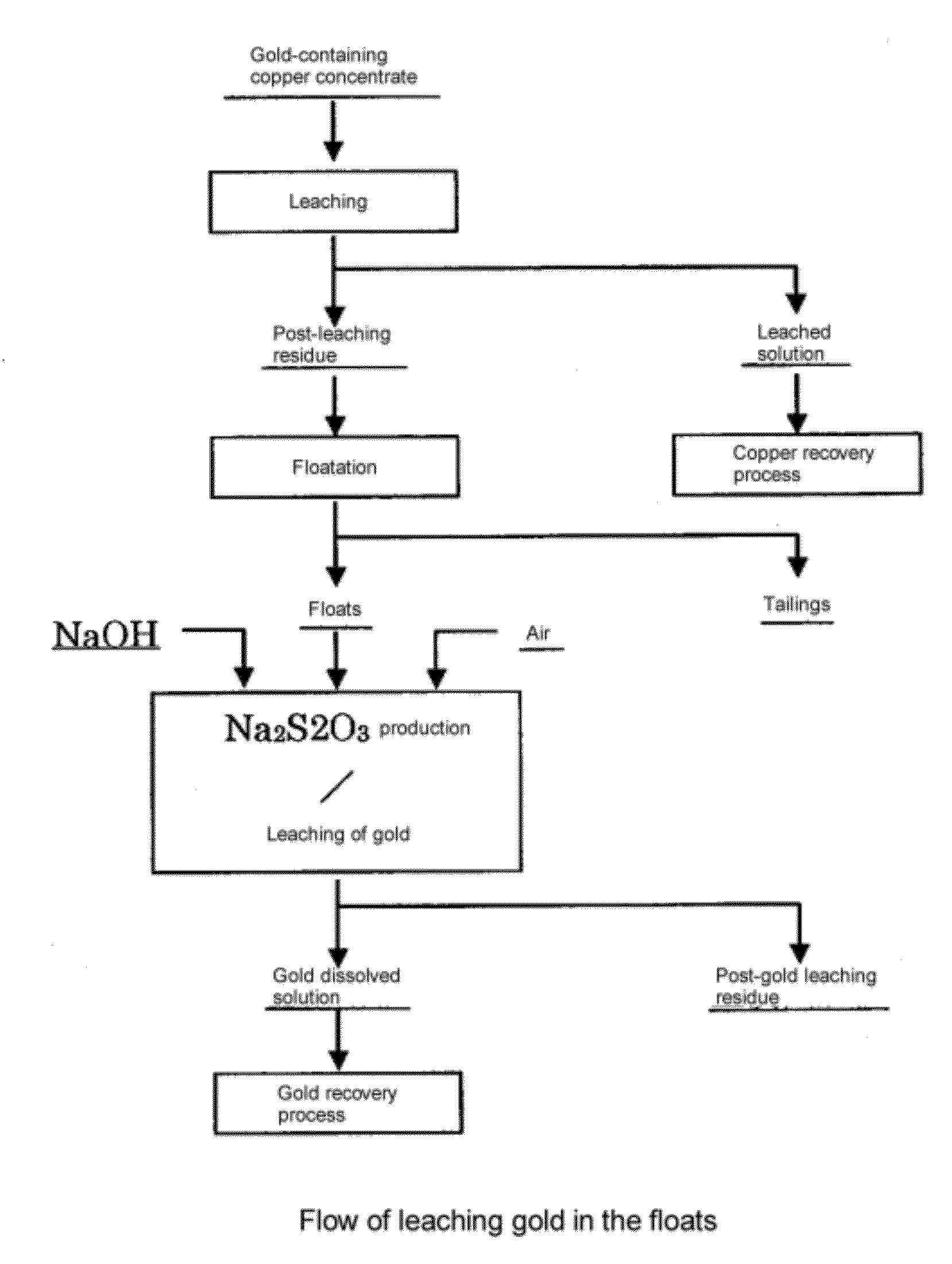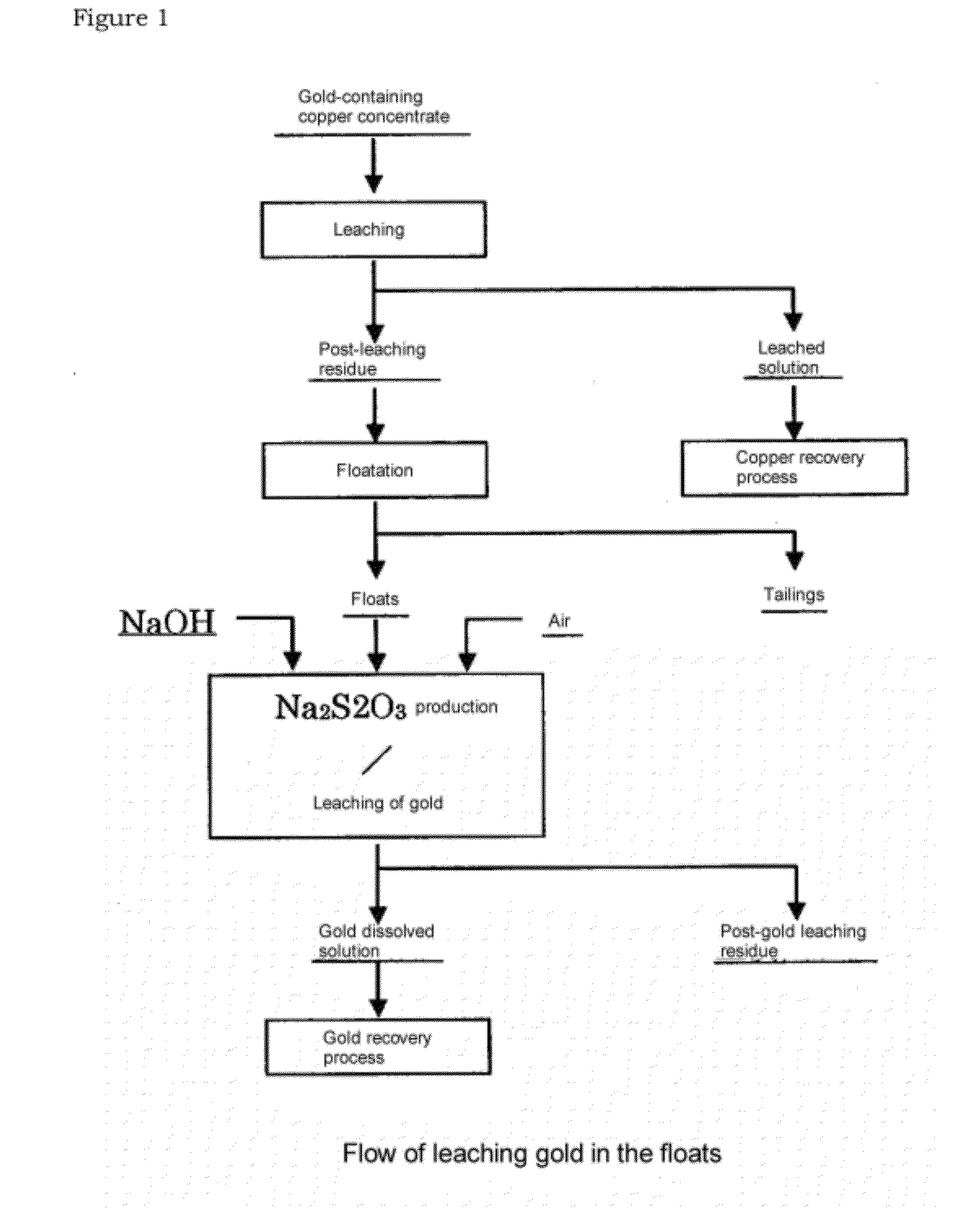Process of leaching gold
a technology of leaching gold and gold, applied in the direction of solid separation, process efficiency improvement, flotation, etc., can solve the problems of increased cost, increased environmental burden, and difficult safety of waste liquid treatment and environmental burden,
- Summary
- Abstract
- Description
- Claims
- Application Information
AI Technical Summary
Problems solved by technology
Method used
Image
Examples
example 1
Effects of Temperature and Time on the Rate of Leaching Gold
[0052]The post-leaching residue obtained after copper was leached with sulfuric acid from copper concentrate was separated, by a floatation, into the floats and tailings. The grade of the floats thus obtained was 45.1 g of gold / t, 0.6 mass % of copper, 14 mass % of iron, and 62 mass % of sulfur.
[0053]75 g of said floats were projected into an aqueous solution of caustic soda of 2.8 mol / L so that the pulp concentration would be 70 g / L, and thus, Au was leached by the produced sodium thiosulfate in each condition described in Table 1. In this case, the amount of caustic soda added is 2 equivalent.
[0054]As the result, while the leach rate of gold for 100 hours was 6% at 25° C., the reaction being promoted by increasing the temperature. At 40° C., the leach rate was 28% for 1 hour, and was 49% for 10 hours. At 60° C., the leach rate was 46% for 1 hour and was 67% for 10 hours. Further, when the temperature was 80° C., the leach...
example 2
Effects of Blowing in Air
[0058]75 g of the same floats as used in Example 1 was projected into 2.8 mol / L caustic soda solution so that the pulp concentration would be 70 g / L, and then Au was leached by the produced sodium thiosulfate produced at a solution temperature of 60° C., with air being blown into the solution at the rate of 1.0 L / min for 1 hour. The result is shown in Table 1. In this case, the leach rate was 56%, which was improved by 10% or more compared to the case where air was not blown.
example 3
Effect of the Amount of Caustic Soda on the Leach Rate of Gold
[0065]150 g of the same floats as used in Example 1 was projected into the caustic soda solution such that the concentration of pulp would be 70 g / L. The concentration of caustic soda was adjusted to have the value of equivalent against sulfur as described in Table 2. Then, under the conditions described in Table 2, without blowing in air, Au was leached with sodium thiosulfate produced, leaching time being 10 hours. The results are shown in Table 2. It can be seen that the leach rate of Au increases according to the increase in the equivalent of caustic soda against sulfur.
TABLE 2LeachingTemp. ofEquivalent of NaOH (to sulfur)solutionLeach ratesol.(° C.)0.512AqueousLeach rate6055%58%67% (Example 1)sol. ofof Au8050%70%89% (Example 1)causticLeach rate6098%99%99% (Example 1)sodaof sulfur8098%99%88% (Example 1)
PUM
| Property | Measurement | Unit |
|---|---|---|
| Temperature | aaaaa | aaaaa |
| Temperature | aaaaa | aaaaa |
| Equivalent mass | aaaaa | aaaaa |
Abstract
Description
Claims
Application Information
 Login to View More
Login to View More - R&D
- Intellectual Property
- Life Sciences
- Materials
- Tech Scout
- Unparalleled Data Quality
- Higher Quality Content
- 60% Fewer Hallucinations
Browse by: Latest US Patents, China's latest patents, Technical Efficacy Thesaurus, Application Domain, Technology Topic, Popular Technical Reports.
© 2025 PatSnap. All rights reserved.Legal|Privacy policy|Modern Slavery Act Transparency Statement|Sitemap|About US| Contact US: help@patsnap.com



